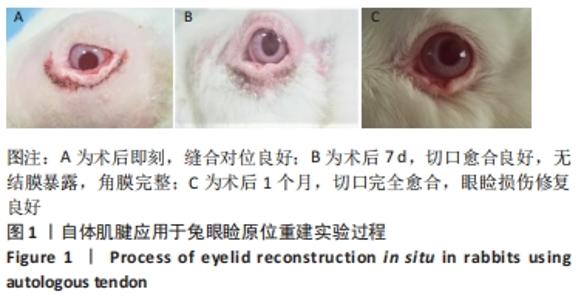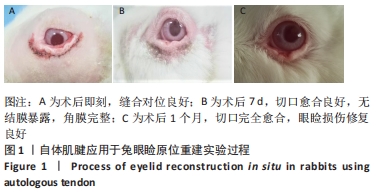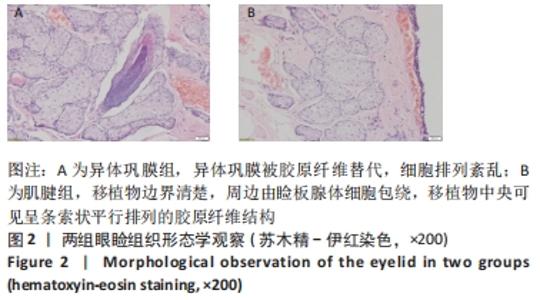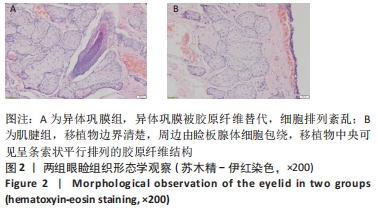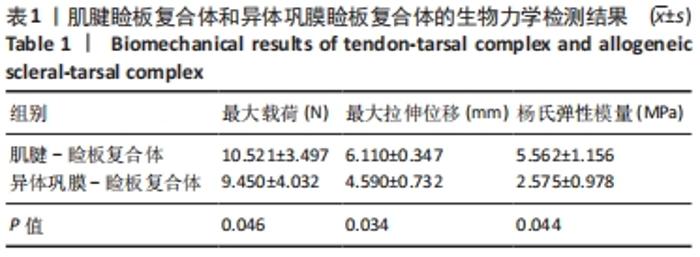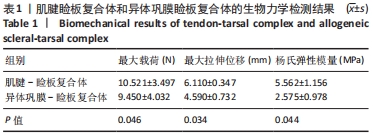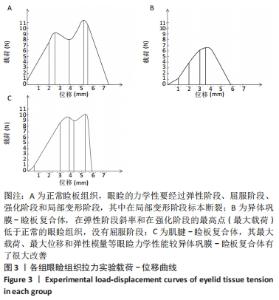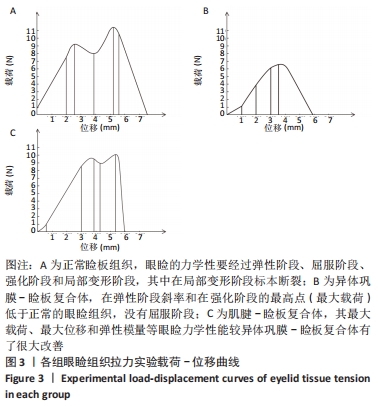[1] 金书红,霍永军,周宁.下睑全层缺损Hughes手术修复的效果观察[J].中华眼外伤职业眼病杂志,2017,39(1):12-14.
[2] 郝胜利.眼睑修复重建手术中睑板替代物的研究进展[J].天津医药, 2019,47(12):1277-1280.
[3] 刘采泮,甘绍乃,叶胜.硬腭粘骨膜移植修复眼睑缺损[J].眼外伤职业眼病杂志,2002,24(6):694.
[4] 胡继发,周太平,潘桔昕.异体巩膜移植治疗眼睑恶性肿瘤术后睑板缺损的临床观察[J].国际眼科杂志,2017(2):373-375.
[5] 章余兰,石璐,宋映,等.异种脱细胞真皮基质联合邻位皮瓣修复眼睑全层缺损的临床观察[J].眼科新进展,2017,37(7):671-673.
[6] 余文,冯光武,谢雅兰,等.应用复合组织修复眼睑缺损的研究进展[J].中国美容整形外科杂志,2019,30(1):60-62.
[7] 袁锋,赵金忠,皇甫小桥,等.自体肌腱重建前交叉韧带后的生物力学转归[J].中国临床康复,2006,10(33):101-103.
[8] 侯立刚,许建中.自体肌腱与人工韧带联合应用重建兔前交叉韧带[J].中国组织工程研究,2008,12(23):4431-4434.
[9] RUBIN P, FAY AM, REMULLA HD, et al. Ophthalmic plastic applications of acellular dermal allografts. Ophthalmology. 1999;106(11):2091.
[10] 周英晋,李军辉,毕宏达,等.外眦锚着技术在邻近睑缘下睑创面修复中的应用[J].中国美容整形外科杂志,2011,22(9):517-519.
[11] 黄成,吕磷,孙笛,等.眼轮匝肌节制韧带辅助修复下睑缺损[J].中国美容整形外科杂志,2019,30(12):740-742.
[12] 李晓红,陈济槐.眼睑缺损的修复[J].中华医学实践杂志,2007,6(1): 40-41.
[13] 胡萌菲,马红利.旋转带蒂皮瓣修复眼睑肿瘤切除后眼睑缺损的效果[J].中华眼外伤职业眼病杂志,2020(1):70-73.
[14] 周水勇,刘玉丽,张羽森,等.眼轮匝肌复合组织瓣在眼睑整形中的临床应用[J].中国医疗美容,2016,6(3):3-5.
[15] 邢新,杨志勇,陈江萍.“风筝”皮瓣在眼睑前层缺损修复中的应用[J].中华医学美学美容杂志,2005,11(1):9-10.
[16] 刘黎平,聂开瑜,王波,等.眶部眼轮匝肌蒂筋膜瓣修复眼睑皮肤缺损[J].遵义医学院学报,2019,42(1):67-70.
[17] GORNEY M, FALCES E, JONES H, et al. One-stage recontruction of substantial lower eyelid margin defects. Plast Reconstr Surg. 1969; 44(6):592-596.
[18] TUNCALI D, ATES L, ASLAN G. Upper eyelid full-thickness skin graft in facial reconstruction. Dermatol Surg. 2005;31(1):65-70.
[19] SLENTZ DH, JOSEPH SS, NELSON CC. The Use of Umbilical Amnion for Conjunctival Socket, Fornix, and Eyelid Margin Reconstruction. Ophthalmic Plast Reconstr Surg. 2020;36(4):365-371.
[20] 叶琳,刘桂琴,彭云.利用对侧眼睑板结膜瓣移植修复大于3/4的上睑后层缺损[J].中国实用眼科杂志,2012,30(10):1224-1226.
[21] 代应辉,岳晓丽,王剑锋.自体硬腭黏膜移植联合眶周皮瓣修复全层眼睑缺损[J].国际眼科杂志,2012,12(6):1185-1187.
[22] 李冬梅,秦毅,陈涛,等.表浅肌肉腱膜皮瓣联合硬腭黏膜移植修复全层眼睑缺损[J].中华眼科杂志,2007,43(12):1064-1068.
[23] 李谊.自体肋软骨移植重建外伤性眼睑缺损临床分析[J].中华实用医药杂志,2003,3(14):1318-1318.
[24] 马红利,蒋安红,李世洋,等.Medpor种植体联合医用耳脑胶修复眼眶爆裂性骨折31例分析[J].人民军医,2018,61(10):945-948.
[25] WONG JF, SOPARKAR CN, PATRINELY JR. Correction of lower eyelid retraction with high density porous polyethylene: The Medpor((R)) Lower Eyelid Spacer. Orbit. 2001;20(3):217-225.
[26] DE JONG-HESSE Y, PARIDAENS DA. [Correction of lower eyelid retraction with a porous polyethylene (Medpor) lower eyelid spacer--Medpor spacer in lower eyelid retraction]. Klin Monbl Augenheilkd. 2006;223(7):577-582.
[27] LI J, LI L, REN BC. Experimental study of the eyelid reconstruction in situ with the acellular xenogeneic dermal matrix. Zhonghua Zheng Xing Wai Ke Za Zhi. 2007;23(2):154-157.
[28] EAH KS, SA HS. Reconstruction of Large Upper Eyelid Defects Using the Reverse Hughes Flap Combined With a Sandwich Graft of an Acellular Dermal Matrix. Ophthalmic Plast Reconstr Surg. 2021;37(3S):S27-S30.
[29] SUN J, LIU X, ZHANG Y, et al. Bovine Acellular Dermal Matrix for Levator Lengthening in Thyroid-Related Upper-Eyelid Retraction. Med Sci Monit. 2018;24:2728-2734.
[30] MCGRATH LA, HARDY TG, MCNAB AA. Efficacy of porcine acellular dermal matrix in the management of lower eyelid retraction: case series and review of the literature. Graefes Arch Clin Exp Ophthalmol. 2020;258(9):1999-2006.
[31] ZHUANG A, SUN J, ZHANG S, et al. Acellular xenogenic dermal matrix as a spacer graft for treatment of eyelid retraction related to thyroid associated ophthalmopathy. Zhonghua Yan Ke Za Zhi. 2019;55(11):821-827.
[32] BARMETTLER A, HEO M. A Prospective, Randomized Comparison of Lower Eyelid Retraction Repair With Autologous Auricular Cartilage, Bovine Acellular Dermal Matrix (Surgimend), and Porcine Acellular Dermal Matrix (Enduragen) Spacer Grafts. Ophthalmic Plast Reconstr Surg. 2018;34(3):266-273.
[33] 张向荣,周琼,肖卫,等.异种脱细胞真皮替代睑板材料重建眼睑的可行性[J].中国组织工程研究,2011,15(3):395-398.
[34] SUN MT, O’CONNOR AJ, MILNE I, et al. Development of Macroporous Chitosan Scaffolds for Eyelid Tarsus Tissue Engineering. Tissue Eng Regen Med. 2019;16(6):595-604.
[35] 武丽萍,杨瑞波,高奕晨,等.壳聚糖及其衍生物在眼科疾病中的应用与研究进展[J].国际眼科纵览,2020,44(2):105-111.
[36] 陈从柏,肖洋.不同成形技术修复眼睑肿瘤切除后缺损的美学效果观察[J].中国美容医学,2017,26(5):75-78.
[37] 赵海波,权琳,薛俊强,等.人脐带间充质干细胞外泌体对大鼠肌腱损伤的修复效果及其机制[J].中华创伤杂志,2021,37(6):562-570.
[38] 于承浩,张益,戚超,等.细胞因子和富血小板血浆对肌腱干细胞的影响[J].中国组织工程研究,2021,25(1):139-146.
[39] 吴松一,周瑞武,李贵洲,等.异体巩膜移植与自体唇黏膜以及邻近皮瓣转移修复眼睑肿瘤切除后眼睑缺损的美容效果对比[J].中国医疗美容,2019,9(10):43-46.
|
